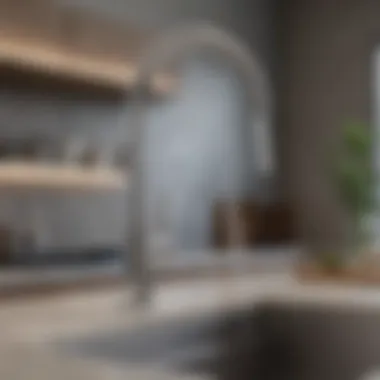Exploring Kitchen Hardware in Miami: A Comprehensive Guide


Intro
The world of kitchen hardware in Miami is unique and multifaceted. This vibrant city hosts a wide range of options for homeowners and designers alike. Understanding how to navigate this diverse landscape is key to selecting the right elements for your culinary space. From layout choices to material quality, there is much to consider.
This guide will provide insights into the various types and styles of kitchen hardware that define Miami's market. With a focus on local vendors, trends, and design inspirations, readers will gain practical knowledge whether they are renovation novices or seasoned interior design enthusiasts.
By the end of this article, you will be equipped with the necessary tools to enhance your kitchen while also appreciating the nuances of Miami's unique aesthetic.
Design Inspiration
Current Trends in Kitchen Hardware
Miami's kitchen hardware scene is constantly evolving. The latest trends reflect broader shifts in interior design. Minimalism, for instance, has gained popularity. Homeowners are seeking sleek, functional hardware that does not overwhelm the other features in the kitchen.
Brushed metals, like stainless steel and matte finishes, are widely appealing. These materials offer a modern look while remaining durable. Additionally, eco-friendly options are also in demand. Brands are now offering sustainable materials that cater to environmentally conscious consumers.
Color Schemes and Palette Ideas
Choosing the right color palette is essential in kitchen design. Soft whites and pastels can bring a light, airy feel to the space. On the other hand, bold colors such as deep blues or vibrant reds can become focal points. Harmonizing your hardware choices with your color scheme is crucial.
Consider these ideas for color palettes:
- Monochromatic: Sticking to shades of one color creates a unified look.
- Contrasting: Pairing dark hardware with light cabinetry adds an interesting twist.
- Natural Elements: Earthy tones combined with wooden accents can evoke comfort and warmth.
"Kitchen hardware not only serves a functional purpose but also enhances the overall design aesthetic of your space."
These trends offer a starting point for exploration. Homeowners can take inspiration from them when selecting their kitchen hardware. With awareness of local styles, any renovation or new build can reflect both personal taste and regional trends.
Prolusion to Kitchen Hardware in Miami
In the culinary heart of a home, kitchen hardware plays a pivotal role. In Miami, where diverse cultures merge and influence design trends, understanding kitchen hardware becomes essential for homeowners and designers alike. Investing in quality hardware enhances not only functionality but also the aesthetic appeal of the kitchen space. This section delves into the significance of kitchen hardware in Miami, emphasizing the specific needs and preferences of the local market.
Understanding Kitchen Hardware
Kitchen hardware comprises various elements that aid in the overall functionality and appearance of a kitchen. This includes cabinet handles, hinges, drawer slides, and faucets, among others. These components are not just functional; they contribute to the kitchen's design and user experience. For example, selecting a chic handle can elevate cabinetry, while choosing the right faucet adds a modern touch to the sink area.
Each piece of hardware serves a unique purpose, impacting daily kitchen activities. Homeowners must consider ease of use, longevity, and style when choosing these items. Accessibility and ergonomic designs can make a significant difference, especially for those who engage in extensive cooking or dining activities.
The Miami Kitchen Hardware Market Overview
The kitchen hardware market in Miami reflects the vibrant culture and lifestyle of its residents. With an array of options available, local vendors cater to various tastes and budgets. From high-end designer pieces to more budget-friendly options, the Miami market offers diversity that aligns with modern and traditional design preferences.
In recent years, demand for sustainable and smart kitchen hardware has risen in Miami. Consumers are increasingly aware of environmental impacts and are opting for eco-friendly materials. Furthermore, the integration of technology into kitchen hardware allows for innovative solutions that enhance usability.
For buyers in Miami, it's crucial to explore both local and online retailers to find the right products that suit their kitchens. Accessible information and a variety of choices empower homeowners to make informed decisions, ensuring their kitchens not only function well but also represent their unique styles.
"Quality kitchen hardware is not just an investment in utility, but also in the overall comfort and enjoyment of culinary spaces."
This article will further explore the various types of kitchen hardware, trends in the market, and valuable insights for selecting quality pieces that fit the dynamic Miami lifestyle.
Types of Kitchen Hardware
In the realm of kitchen design, hardware is often overlooked, yet it plays a critical role in both aesthetics and functionality. Understanding the different types of kitchen hardware is essential for homeowners who wish to create a space that is not only visually pleasing but also practical for everyday use. From cabinet handles to sink faucets, every piece of hardware serves a specific purpose and contributes to the overall feel of the kitchen. Different styles can define a kitchen's character, influencing its usability and integrative aspects.
Cabinet Handles and Knobs
Cabinet handles and knobs are amongst the most prominent hardware pieces in any kitchen. They not only serve as functional elements for opening doors or drawers but also act as stylistic accents that can elevate the aesthetic appeal of the space.
Materials Used
The choice of material for cabinet handles and knobs significantly impacts both durability and appearance. Common materials include stainless steel, brass, ceramic, and glass. Each material offers unique characteristics:
- Stainless Steel: Known for its durability and modern appearance. It resists rust and is easy to clean.
- Brass: Adds a touch of warmth and elegance, though it may require more maintenance to prevent tarnishing.
- Ceramic: Available in various colors and designs, giving a personal touch, but it might chip or break more easily.
- Glass: Provides a sleek look but may not be as robust as metal options.
These materials influence how a kitchen feels and functions. The right choice fosters a harmonious balance between beauty and endurance.
Design Trends


Currently, several design trends are shaping the market for cabinet handles and knobs. Minimalistic designs, characterized by clean lines and understated forms, reflect the contemporary aesthetic favored by many homeowners today. Additionally, mixed materials, such as combining metal with natural wood, are becoming more popular. These trends allow for customization and can match various kitchen themes from traditional to modern. Unique designs, such as geometrical shapes, are also worth noting, allowing for creative expression and individual style.
Drawer Slides and Rails
Drawer slides and rails are vital components that ensure ease of access to stored items. Their efficiency impacts the overall functionality and organization of the kitchen.
Types of Slides
There are mainly three types of drawer slides available:
- Side-Mount Slides: Commonly used and easy to install. They provide good stability.
- Under-Mount Slides: Hidden from view and offer a sleek appearance, ideal for modern kitchens.
- Ball-Bearing Slides: Provide smooth movement and handle heavier loads well, making them a reliable choice.
Understanding the type of slides is crucial as it affects how well drawers operate and their longevity.
Installation Considerations
Proper installation of drawer slides is essential for optimal functionality. Factors to consider include the weight capacity of the slide, the alignment with the cabinet, and ensuring smooth movement. Measure carefully before installation to avoid errors. Incorrect installation may lead to drawer issues, which can be frustrating and costly.
Hinges and Latches
Hinges and latches are mechanisms that support doors and provide secure closures. They are essential for maintaining the integrity of cabinetry and contribute to user convenience.
Types of Hinges
Different types of hinges serve various functional and aesthetic purposes:
- Standard Hinges: Simple and reliable for most cabinets.
- Soft-Close Hinges: Ideal for reducing noise when closing; very pleasant in everyday use.
- Servo-Drive Hinges: Equipped with automatic opening features that impress with modern technology.
Selecting the appropriate hinge type influences the performance and usability of cabinets, enhancing the kitchen experience.
Choosing the Right Latches
Choosing latches should not be based solely on design but also functionality. A well-constructed latch ensures that cabinet doors remain closed. There are different securing mechanisms as well, such as magnetic latches or traditional catches. Each latch should match the cabinet style and the frequency of use. High-quality latches prevent wear and enhance the longevity of cabinetry.
Sinks and Faucets
Sinks and faucets are pivotal in any kitchen. They are frequently used and can greatly dictate the workflow within the space.
Popular Materials
Materials for sinks and faucets range from stainless steel, which is highly durable, to ceramic and copper, each bringing distinct advantages:
- Stainless Steel: Offers a sleek finish and robustness but is vulnerable to scratching.
- Ceramic: Comes in various designs and colors but can be prone to cracking.
- Copper: Known for anti-microbial properties but requires careful maintenance.
Material selection profoundly affects not just utility, but cleanliness and maintenance requirements in the kitchen.
Functionality Factors
When considering functionality, aspects such as faucet height, spray options, and water flow rates should not be overlooked. A high-arc faucet, for instance, allows greater clearance for washing large pots, while a pull-down sprayer adds convenience. The right combination of sink and faucet can transform everyday tasks into efficient, enjoyable experiences.
Selecting Quality Kitchen Hardware
Choosing quality kitchen hardware is crucial for both functionality and aesthetic appeal. In a space where efficiency and beauty coexist, selecting the right components ensures that the kitchen operates well and enhances its overall look. Kitchen hardware should be durable, reliable, and match the home's interior design. With the variety of options available to homeowners in Miami, understanding the elements of quality can make a significant difference in satisfaction and longevity.
Evaluating Material Quality
Metal vs. Plastic
When evaluating kitchen hardware, one of the most significant distinctions is between metal and plastic options. Metal hardware, typically made from materials like stainless steel, brass, or aluminum, offers durability and a classic aesthetic that appeals to many homeowners. Its resistance to wear and tear makes it a popular choice for high-use areas such as kitchens. On the other hand, plastic hardware is lighter and can be available in numerous colors and styles. While cheaper, plastic may not endure heavy use as well as metal.
When choosing between metal and plastic, consider the specific needs of your kitchen space. Metal hardware generally offers a more timeless look, while plastic can add a pop of color and modern flair but may become worn or damaged over time.
Finish Durability
The finish on kitchen hardware plays a crucial role in maintaining appearance and resistance to damage. Finish durability refers to how well a coating can withstand time, moisture, and wear. Popular options include chrome, brushed nickel, and oil-rubbed bronze. These finishes can protect the underlying metal from corrosion and provide easy cleaning. However, some finishes may show scratches or tarnish over time, which makes understanding the different types essential before making a purchase.
A durable finish contributes not just to a continuous polished look but also to the hardware's maintenance. In kitchens where aesthetics are important, choosing hardware with tough finishes can result in fewer replacements and a consistently vibrant design.
Functionality Considerations


Usability and Ergonomics
Usability and ergonomics are critical considerations in selecting kitchen hardware. Usability pertains to how easy and intuitive the hardware is to operate. Ergonomic designs minimize strain and allow for more fluid movements in the kitchen. For instance, a well-positioned faucet can significantly reduce the hassle of washing dishes, while knobs that fit comfortably in the hand can enhance overall kitchen experience.
By focusing on usability and ergonomics, homeowners can ensure their kitchen remains a practical space. This consideration aids in daily tasks, making cooking and cleaning more enjoyable and efficient.
Weight Capacity
Weight capacity is another essential aspect to consider. Different hardware types have varying limits on how much weight they can handle. For example, cabinets need strong hinges and latches that can support the weight of heavy doors. Drawer slides must also accommodate the weight of their contents without failure.
Understanding the specific weight capacities will lead to better functioning kitchen hardware. This can prevent issues such as sagging doors or stuck drawers, which detract from the kitchen's usability.
Selecting the right kitchen hardware involves considering these various factors. High-quality materials, durability of finishes, usability, ergonomics, and weight capacity will all contribute to a well-functioning kitchen that lasts.
When making decisions, keep in mind both functionality and style, as they are intricately linked to a successful kitchen design.
Current Trends in Kitchen Hardware
Understanding current trends in kitchen hardware is crucial for homeowners and designers looking to create functional yet stylish spaces. The adoption of innovative materials and technologies reflects an evolving mindset towards sustainability and convenience. By recognizing these trends, one can make informed decisions that enhance the overall appeal and functionality of their kitchens.
Sustainable Materials
Sustainability has become a significant focus for many consumers today. This shift is seen clearly in the demand for sustainable materials in kitchen hardware.
Recycled and Eco-Friendly Options
Recycled and eco-friendly options are now prominent in the market. These materials, often sourced from post-consumer waste, reduce environmental impact while maintaining aesthetic appeal. The key characteristic of recycled materials is their ability to lower carbon footprints compared to traditional options. For instance, bamboo and reclaimed wood are popular for cabinet pulls and knobs. They add a unique charm to the kitchen while being environmentally responsible.
The unique feature of eco-friendly options is their versatility, allowing them to fit various design styles, from modern to rustic. However, some may find the initial pricing higher than conventional hardware. Long-term savings through durability and their contribution to a healthier environment often outweigh these costs.
Consumer Demand
Consumer demand for sustainable products continues to rise. Homeowners increasingly seek kitchen hardware that is not only functional but also reflects their values.
A key characteristic of this demand is the growing awareness of environmental issues. This societal shift drives manufacturers to innovate, resulting in a broader range of eco-friendly choices. A unique feature of this trend is the increasing availability of certifications. Products may have labels confirming their sustainability, making it easier for buyers to choose responsibly.
Such options appeal to homeowners looking to contribute positively to the environment while enjoying high-quality, trendy products. The challenge lies in meeting the balance between cost, aesthetic preference, and sustainability.
Smart and Innovative Hardware
Smart and innovative hardware is reshaping kitchens, merging convenience with modern technology in practical ways.
Technology Integration
Technology integration in kitchen hardware enhances usability, allowing homeowners to enjoy a seamless cooking experience. The key characteristic of smart technology is its ability to connect with home automation systems. It enables features like hands-free faucet activation and smart sinks with built-in purification systems.
Unique features like voice activation and remote control access become integral for cooking efficiency. While initial setups might require a larger investment, the convenience it brings can lead to time savings and enhanced functionality over time.
User Experience
User experience is central to the advancement of kitchen hardware. This trend emphasizes intuitive designs that prioritize comfort and ease of use.
The key characteristic of improved user experience is ergonomic design. For instance, handles designed for better grip or sinks with adjustable heights cater to a wide range of users. A unique feature of this focus is the enhanced accessibility for individuals with disabilities, promoting inclusivity in kitchen design.
Despite the advantages, some homeowners might hesitate to adopt high-tech solutions due to familiarity with traditional hardware. Education about benefits and user-friendliness can help mitigate these concerns.
Local Vendors and Resources
The role of local vendors and resources in the kitchen hardware market of Miami is significant. The community relies on these establishments not just for products, but also for expertise and guidance. Local vendors understand the unique preferences and styles prevalent in the Miami area. Their insights can provide homeowners with tailored solutions that fit the aesthetic and functional needs of their kitchens.
Local resources also contribute to the economy, promoting small businesses that often offer personalized customer services. Shoppers typically find that they can engage in meaningful conversations with sales representatives who have experience and knowledge about the products. This can lead to better-informed purchasing decisions and a higher likelihood of satisfaction with the chosen hardware.
Top Kitchen Hardware Stores in Miami
Store Profiles
In Miami, the variety of kitchen hardware stores reflects the city's diverse population and design preferences. Each store typically has its own unique character. Some specialize in high-end, designer products, while others offer more budget-friendly options. These profiles of stores highlight the key characteristics that attract customers.


For instance, a store like Ferguson stands out due to its extensive selection of both style and functionality in kitchen hardware. Another example is The Home Depot, known for its vast inventory and competitive prices. These stores cater to a wide audience, from professional designers to enthusiastic DIYers. The advantages of larger retailers include broad product availability, while smaller boutique stores may offer curated collections with specialized service.
Product Offerings
The product offerings in Miami's kitchen hardware stores are diverse and cater to various tastes. Many stores provide a comprehensive selection, from cabinet knobs to sink fixtures. This variety is essential for homeowners seeking to create a cohesive look in their kitchens.
For example, IKEA provides an extensive range of modern, functional hardware at affordable prices. This can be ideal for those on a budget. In contrast, B stores like Tansu focus on artisan-crafted hardware that often has unique designs and finishes. This advantage allows those looking for distinctive items to find exactly what they want for their projects.
Online Retailers with Miami Focus
Comparative Analysis
Online retailers are an increasingly popular choice for consumers seeking kitchen hardware in Miami. Conducting a comparative analysis among these retailers helps potential buyers understand the options available. Retailers like Wayfair and Amazon offer convenience through extensive selections and competitive pricing.
However, local companies such as Home Hardware excel in demographic specificity. They provide products that resonate better with local tastes and trends. This can make a difference for customers wanting products reflective of Miami's vibrant culture. The added value is often found in the unique designs that echo the surroundings, making them more appealing.
Delivery Services
Delivery services provided by online retailers is a key factor for many consumers. The effectiveness of delivery options can greatly influence buyer choices. Many retailers have established networks that ensure fast delivery times, which is particularly appealing to individuals who want to start their kitchen renovations promptly.
For example, Wayfair is known for its rapid shipping policies which can be a significant advantage. In contrast, local retailers may offer personalized delivery services, providing an intimate touch that enhances the buying experience. However, this may result in longer waiting periods. Balancing efficiency and personal service often shapes the final purchasing decision for customers who are serious about their kitchen hardware projects.
DIY Kitchen Hardware Projects
DIY kitchen hardware projects are significant in the overall narrative of kitchen design in Miami. They not only offer personalization to spaces but also provide practical benefits. Engaging in DIY activities can lead to cost savings and allows for unique customization that reflects personal style and preferences. Furthermore, the Miami market appreciates creativity and resourcefulness, making DIY projects ideal for homeowners who wish to incorporate distinctive elements into their kitchens.
Upcycling Old Hardware
Techniques and Tips
Upcycling old hardware involves transforming what is available into something fresh and appealing. This technique fosters sustainability while embracing creativity. For instance, repainting worn-out knobs or handles can refresh their look. Common methods include sanding, refinishing, or even reassembling pieces to create a new design.
One key characteristic of upcycling is its cost-effectiveness. It minimizes waste and reduces the need to purchase new items. It also encourages individuals to explore their creativity by modifying existing materials. The unique feature of this technique is that it provides endless possibilities, limited only by one's imagination. However, one challenge is that not all materials are equally suitable for upcycling, which may require careful selection.
Tools Required
Using the right tools is essential for any upcycling project. Basic items like sandpaper, paintbrushes, and screws can go a long way in achieving desired results. Additionally, more specialized tools like a drill or a soldering iron might be needed depending on the project complexity. This simplicity makes it an accessible choice for many homeowners in Miami.
A notable advantage of having proper tools is increased efficiency; projects can often be completed quickly and with a professional finish. However, the downside could be the initial investment in tools, especially for those new to DIY projects.
Installing New Hardware
Step-by-Step Guide
Installing new hardware can significantly elevate the look of a kitchen. A step-by-step guide helps streamline the process, making it manageable even for beginners. First, gather all necessary tools and materials, which may include screws, a screwdriver, and a measuring tape.
A distinctive feature of a guide like this is its structured approach, breaking tasks into simpler steps. One of the primary advantages is ensuring proper alignment and function, which can greatly impact the aesthetic and usability of the kitchen hardware. The downside is that mistakes in installation can lead to damage or require additional fixes.
Common Mistakes
Understanding common mistakes in this process can save considerable time and effort. Many individuals may overlook the importance of measuring correctly, which can result in misaligned hardware. Another frequent error is using unsuitable screws, which may not hold properly.
Highlighting these mistakes is beneficial as it educates readers on best practices. The unique aspect here is that knowing what to avoid prepares individuals better, enhancing their DIY skills. While learning from mistakes is part of the process, avoiding them in the first place is ideal to maintain efficiency and aesthetic quality.
Epilogue and Final Thoughts
The exploration of kitchen hardware in Miami unveils critical insights into the components and elements that contribute to effective kitchen design. As homeowners and designers embark on renovating or building spaces, they must recognize the significance of quality hardware. Well-chosen kitchen accessories not only enhance aesthetics but also optimize functionality. Quality kitchen hardware can result in durability, ease of use, and overall satisfaction in daily operations.
The Importance of Quality in Kitchen Design
Quality in kitchen design extends beyond mere appearance; it encompasses functionality, durability, and user experience. Homeowners in Miami should prioritize investment in high-quality hardware. This investment pays off in the long run through reduced maintenance and replacement costs. For instance, cabinet handles made from robust materials like stainless steel can withstand daily wear better than cheaper alternatives.
- Durability: Quality hardware is built to last, resisting rust and corrosion, especially in the humid Miami climate.
- Functionality: Ergonomically designed pieces promote efficiency in the kitchen, making tasks like cooking and cleaning less laborious.
- Aesthetic Appeal: High-quality materials often offer better finishes and design options, ensuring that the kitchen remains stylish and modern.
A well-designed kitchen that incorporates quality hardware can improve the home's value significantly, making it appealing to future buyers. Therefore, discerning homeowners should consider their kitchen hardware selection as a key element of their overall interior design strategy.
Future of Kitchen Hardware in Miami
As Miami continues to evolve, so does the kitchen hardware market. Trends are shifting towards sustainable materials and smart technologies. Homeowners should stay informed about these innovations to enhance their kitchen setups.
Sustainable Materials: As consumers become more environmentally conscious, there is growing interest in eco-friendly options. Brands that utilize recycled materials or sustainable sourcing methods are gaining popularity.
Smart Technologies: Integration of smart hardware, like touchless faucets and connected appliances, marks a new era in kitchen design. Such applications not only add convenience but also enhance energy efficiency.
"Staying ahead of trends can significantly enhance the functionality and appeal of kitchens in Miami, ensuring that homeowners make informed choices."



